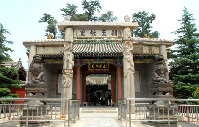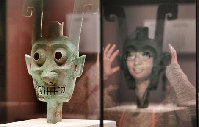Laos pushes for world heritage proposals
Updated: 2014-03-04 15:08
(Xinhua)
|
||||||||
The Lao government has announced it will accelerate attempts to have the Plain of Jars and Phou Hin Nam Nor (Stone Pillar Mountain) listed as world heritage sites, state-run daily Vientiane Times reported on Tuesday.
Deputy Director General of the Heritage Department under the Ministry of Information Culture and Tourism Viengkeo Souksavatdy was quoted as saying that prompt action is being taken to examine the remaining steps for submitting the Plain of Jars to the nomination dossier list to be considered by the world heritage committee during its annual meeting.
Several years ago the government submitted the Plain of Jars to the tentative list of the world heritage committee.
|
|
|
|
The Plain of Jars is a megalithic archeological landscape scattered throughout the Xieng Khouang plateau. Thousands of stone jars, often appearing in clusters of one to several hundred are scattered around the lower foothills.
The jars range from 1 to 3 meters in height and are dated to the Iron Age (500 BC to AD 500). The Plain of Jars is considered to be one of the most important sites for studying Southeast Asian prehistory.
For Stone Pillar Mountain, officials must complete the necessary documents to propose entry to the tentative list first, said Viengkeo.
The Stone Pillar Mountain area covers 82,000 hectares and comprises of a multitude of rocky outcrops that resemble a stone forest.
Experts say the unusual formation may have been caused by a volcanic eruption many hundreds of years ago. In 2005 the Laotian rock rat living in the area, Laonastes Aenigmamus, was identified as the sole survivor of an ancient group of rodents thought to have become extinct 11 million years ago.
Viengkeo was unable to provide an exact date for the submission of the proposals, saying that no submission date was set in stone during recent deliberation on the topic.
So far Lao PDR has two United Nations Educational, Scientific and Cultural Organization (UNESCO) world heritage listed sites. One is the city of Luang Prabang, a city located in north central Laos at the confluence of the Nam Khan and Mekong Rivers with a population of approximately 50,000. The city is known for its numerous Buddhist temples and monasteries.
Lao PDR's second world heritage site is Vat Phou, a ruined Khmer temple complex in the south of the country. The complex is located at the base of mount Phu Kao and was a temple dating from as early as AD 400 with surviving structures dating from AD 1000- 1200.

 Gorgeous Liu Tao poses for COSMO magazine
Gorgeous Liu Tao poses for COSMO magazine
 Post-baby Duchess
Post-baby Duchess
 Victoria Beckham S/S 2014 presented during NYFW
Victoria Beckham S/S 2014 presented during NYFW
 'Despicable' minions upset Depp's 'Lone Ranger' at box office
'Despicable' minions upset Depp's 'Lone Ranger' at box office
 'Taken 2' grabs movie box office crown
'Taken 2' grabs movie box office crown
 Rihanna's 'Diamonds' tops UK pop chart
Rihanna's 'Diamonds' tops UK pop chart
 Fans get look at vintage Rolling Stones
Fans get look at vintage Rolling Stones
 Celebrities attend Power of Women event
Celebrities attend Power of Women event
Most Viewed
Editor's Picks

|

|

|

|

|

|
Today's Top News
US halts military engagements with Russia
First Lady to visit China in March
Terrorists in Kunming attack busted
Gravity, Slave Oscar winners
2014 the year of the Chinese IPO?
China making progress on fighting pollution: experts
Michigan benefits from ties with Chinese
Detroit toasts all time high in China trade
US Weekly

|

|









